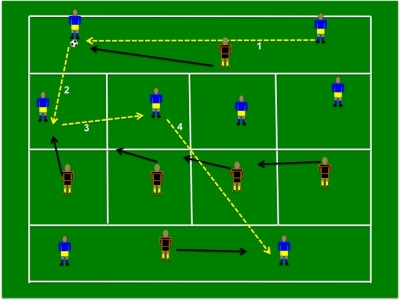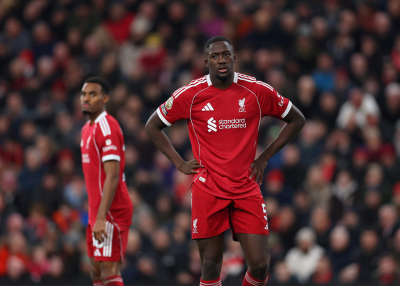Football News: Midfielders - Part 1

Image from: coachdibernardo.com
Midfielders - Part 1
This article was requested by Harry on the Liverpool site, what he actually asked for was: "A comprehensive write ups on midfield and midfielders, referring to different types and it's importance to every system. Examples of teams and players who fits in those." So I will leave it to you readers to decide how well I fulfil his request!
I am going to begin with the deeper lying midfielders, those that play mainly in front of the defensive line, not always for defensive purposes.
Firstly there is the true defensive midfielder, sometimes called a holding midfielder or anchor man, someone who rarely ventures forward but holds in front of a back 3/4/5 to protect it. It is a role often played by a player who can also play in the centre of defence, such as Eric Dier, Javi Martinez, Gary Medel (in recent years) and David Luiz. The most famous example is Claude Makelele, who was so successful in the role it is often called the 'Makalele position'.
Argentina have played with a player in that position for many years, they call it the 'Number 5' role, and he was often the most important player on the pitch with his ability to break up opponents' attacks and give the ball to the better players. Some of the best number 5s were also decent creatively, which added an extra facet to the play. However the roles primary function is destructive.
While its function is destructive, the reason for using it is to free up the attacking players to be more attacking, to allow more freedom and creativity. Knowing they have someone like that covering them, it opens up the possibility to make more forward runs into dangerous areas, as Manchester United have shown this season since the arrival of Nemanja Matic. Suddenly the attacking players are not having to keep half an eye on the need to chase back.
When played in front of a back 4, these players will often drop inbetween the centre backs when the fullbacks are advanced, this allows the centre backs to spread out and cover the wide areas and play the ball between them when in possession. That has replaced the older tactic of playing with just one fullback going forward at a time, to keep three at the back, and allowed teams to use wing backs with some degree of safety.
Then there is the deep lying playmaker, there is some crossover with players such as Matic being capable of playing the ball forward from a deeper position, but it is not the main reason he is in the side. The deep lying playmaker is expected to help protect the back line, but his main role in the side is to play the ball out from deep, often looking for quick balls over the top. To be truly effective in the role, they need good vision and an excellent range of passing, as well as the positional sense of a defensive midfielder.
Without a doubt the most obvious example of this type of player is the recently-retired Xabi Alonso, who is probably the best in that role I have seen. Defensively he was up there with the best of the purely defensive midfielders, having excellent positioning, so good, in fact, that the Real Madrid team he played in was shaped around him and his talents. On the ball his passing was pinpoint, again up there with the best players in the game, which made him an extremely valuable asset. However, players playing his role tend to sacrifice a little in the defensive area for the ability to pick a pass.
Quick counter attacks usually come from them picking off a pass or winning the ball in a challenge and playing it quickly forward into space for a pacey attacker to run onto. It was the role that Brendan Rodgers tried to convert Steven Gerrard to later in his career, though Gerrard was never entirely able to get the hang of the defensive side and sometimes slipped up allowing opponents in. Unlike the defensive midfielder, the deep lying playmaker wants the ball at his feet, he is the fulcrum of his team, while the defensive midfielder is there to give it to someone else in most instances, the playmaker is the one who players look to give the ball to.
The final main type is what is often called the Regista. It is more easily described as the Andrea Pirlo role. Defensively virtually non-existent, the sole function of these players is to create, in Pirlo's case he often got out of the way of attackers rather than looked to stop them! The only reason they play deeper is to give themselves more time on the ball to look for the right pass to play. That can often be negated by a pressing team.
This role requires good movement in front of him to pass to or his quality on the ball will be in too deep an area to hurt the opposition. Often opponents will look to play an attacking midfielder or second striker in the area he likes to operate to cut down on his time and space on the ball. If a regista is given time and space on the ball, despite playing so deep, he can create chances to hurt his opponent with his passing range.
While there are other variant positions that play deep, in essence they are all just slight tweaks to the way these 3 play, or a combination of 2 of them. Some deep lying players are more aggressive in their attempts to win the ball, such as Javier Mascherano or Gary Medel when playing there. Looking to win the ball back early and by physical means, with neither really possessing the pace to get involved in racing back to the box, they would use that aggression, as much as possible, to negate the need to chase back.
Some play the role more in the way of Jordan Henderson, who looks to jockey opponents into making mistakes, using pressure of blocking their pass routes and covering their space to run with the ball. They prefer not to commit to a challenge, to stay on their feet to avoid being bypassed.
The main variation I have seen recently is Pep Guardiola's half fullback/half holding midfielder. Where many holding midfielders will drop between the centre backs to allow them to cover when the wing backs have got forward, Pep decided to try something different. At the start of last season, he had both fullbacks move into the defensive midfield area when Manchester City were on the ball, then dropping back into the fullback areas when possession was lost. While it was innovative, it did not work well as it left a huge gaping hole in midfield when possession was lost and opponents exploited it once they realised it.
Last time out in the Premier League, Pep tried a variation of that which partially solved the issue of an empty midfield. This time he played Fernandinho as a holding midfielder with Fabian Delph stepping in alongside him into midfield when they had possession. The other fullback, Kyle Walker, stayed back mostly as a central defender, to create a 3 centre backs system behind Delph and Fernandinho. This solved the issue of an empty midfield when possession was lost, though it was interesting to see it did mean a more old-fashioned approach to the use of fullbacks, who were not used as the focal point of attack, instead the good old winger provided width.
Written by Tris Burke October 14 2017 08:55:16


